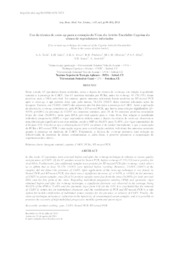Uso da técnica de swim-up para a remoção do Vírus da Artrite Encefalite Caprina do sêmen de reprodutores infectados.
Uso da técnica de swim-up para a remoção do Vírus da Artrite Encefalite Caprina do sêmen de reprodutores infectados.
Author(s): ÁVILA, A. A.; SIDER, L. H.; VERAS, A. K. A.; PINHEIRO, R. R.; OLIVEIRA, M. L. M.; SILVA, P. A. F.; SOUSA, S. D.; ANDRIOLI, A.
Summary: Resumo: Neste estudo, 67 ejaculados foram avaliados, antes e depois da técnica de swim-up, em relação à qualidade seminal e à presença do CAEV. Das 67 amostras testadas por PCRn, antes do swim-up, 47 (70,15%) foram positivas para o DNA pró-viral. No entanto, quatro amostras adicionais foram positivas ao RT-nested PCR após o swim-up, o que permite dizer que, pelo menos, 76,12% (51/67) delas estavam infectadas antes da lavagem. Todavia, em 23,88% (16/67) das amostras não foi detectada a presença do CAEV. Após a aplicação da técnica de swim-up, constatou-se, pela PCRn e RT-nested PCR, que houve uma redução significativa (X²= 9,078; p<0,001) da presença do CAEV nas amostras seminais, pois 28 de 51 amostras positivas resultaram livres do vírus (54,90%), tanto para DNA pró-viral quanto para o vírus livre. Em relação à motilidade individual progressiva (MIP) e vigor espermático obtidos antes e depois da técnica de swim-up, observou-se uma diminuição significativa em suas médias, sendo o MIP de 86,42% para 71,49%, já o vigor espermático de 4,16 para 3,93. Conclui-se que a eliminação do CAEV no sêmen é de caráter intermitente, e que a associação da PCRn e RT-nested PCR é uma opção segura para a certificação sanitária individual das amostras seminais quanto à presença ou ausência do CAEV. Finalmente, a técnica de swim-up promove uma redução na infectividade de amostras de sêmen contaminadas, e, além disso, é possível promover a recuperação de espermatozoides viáveis. [Use of swim-up technique for removal of the Caprine Arthritis Encephalitis Virus in the semen of infect bucks]. Abstract: In this study, 67 ejaculates were assessed before and after the swim-up technique in relation to semen quality and presence of CAEV. Of the 67 samples tested by Nested PCR, before swim-up 47 (70.15%) were positive for viral DNA. Furthermore, four additional samples were positive for RT-nested PCR after swim-up, which allows us to affirm that at least 76.12% (51/67) were infected before washing. However, 23.88% (16/67) of the samples did not detect the presence of CAEV. After application of the swim-up technique it was found, by Nested PCR and RT-nested PCR, that there was a significant decrease (X² = 9.078, p <0.001) in the presence of CAEV in semen samples, once 28 of 51 positive samples were free from the virus (54.90%) for both proviral DNA and the free form of the virus. Regarding individual progressive motility (IPM) and spermatic vigor obtained before and after the swim-up technique, a significant decrease was observed in the average, being 86.42% of the IPM to 71.49% and the spermatic vigor from 4.16 for the 3.93. It is concluded that the removal of CAEV in semen has an intermittent character, and the combination of PCR and RT-nested PCR is a safe option for health certification of individual semen samples for the presence or absence of CAEV. Finally, the swim-up technique promotes a reduction in the infectivity of contaminated semen samples, and it is possible to promote the recovery of high individual progressive motility sperm and sperm vigor.
Publication year: 2015
Types of publication: Journal article
Unit: Embrapa Goats & Sheep
Observation
Some of Embrapa's publications are published as ePub files. To read them, use or download one of the following free software options to your computer or mobile device. Android: Google Play Books; IOS: iBooks; Windows and Linux: Calibre.
Access other publications
Access the Agricultural Research Database (BDPA) to consult Embrapa's full library collection and records.
Visit Embrapa Bookstore to purchase books and other publications sold by Embrapa.

